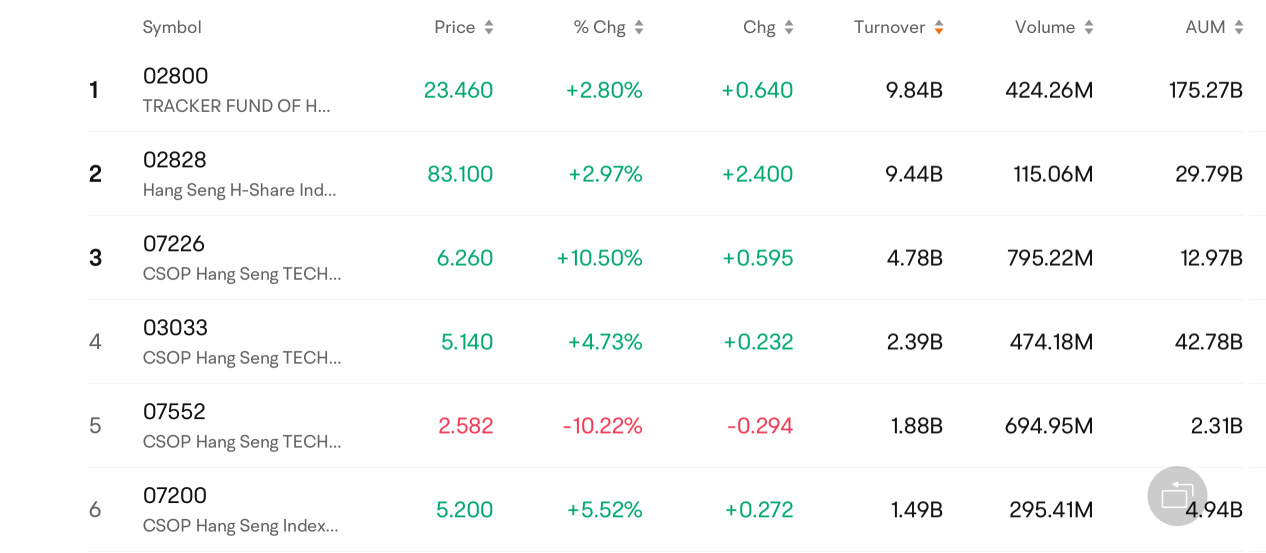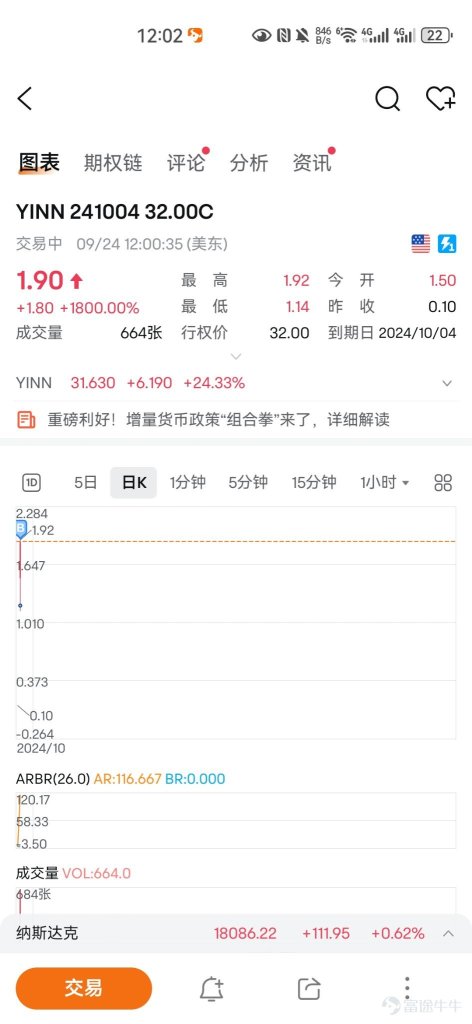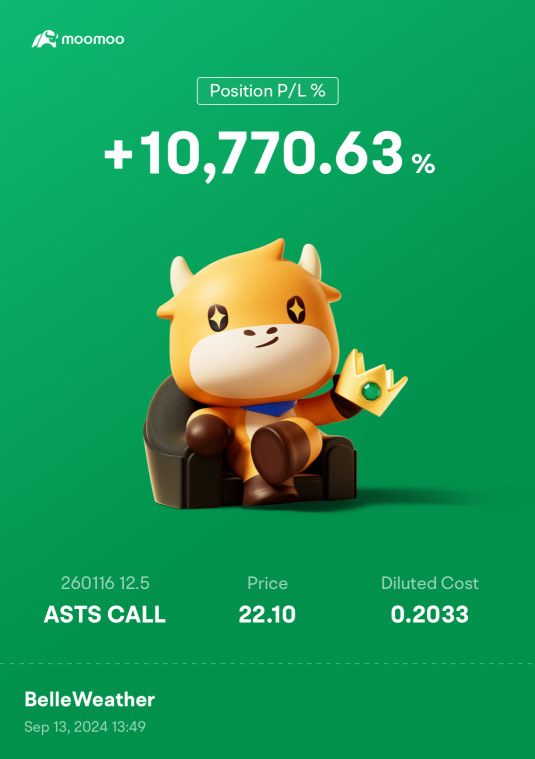$SG#HSI RC2710L.C (58460.HK)$ Can usa residents not trade bull and bear certificates of Hong Kong stocks? Order placement failed.
Translated
贺旺 he0000
liked
$NVIDIA (NVDA.US)$ $Advanced Micro Devices (AMD.US)$ $Direxion Daily Semiconductor Bull 3x Shares ETF (SOXL.US)$
First, let's understand the techniques for using these 6 core stock indicators.
DKW: a trend indicator that uses a dual-color ladder to determine bullish and bearish market conditions. Buy and sell points are determined based on the structure digits [1-9] and arrow prompts.
CD: a bottom-fishing signal indicator. Red represents bullish market conditions, while orange-yellow represents bearish market conditions. A relatively suitable buy and sell point can be found by observing the color changes of the DKW trend ladder and the CD indicator, as well as the corresponding prompts [buy point, liquidation].
CM: a chip indicator. Orange-yellow represents the entry of institutional investors, usually indicating a bullish market trend. Blue represents individual investors, usually indicating a bearish market trend. When hot money enters a stock, it indicates that the stock may have a strong short-term breakout with a significant increase in price.
SXHY: [Three-in-One Indicator] Green represents resistance, red represents trendlines, and yellow represents support. When the three lines come together, it's a long position, and when they separate it's a short position.
STZ: Three-Wave Resonance Indicator, optimized with the advantages of KDJ and MACD indicators, strengthening the accuracy of DKW buy and sell points, requires the use of combination.
CKDJ: The super stochastic indicator strengthens DKW, CD, and STZ based on the strength and weakness of the stock price trend and the overbought and oversold phenomenon.
First, let's understand the techniques for using these 6 core stock indicators.
DKW: a trend indicator that uses a dual-color ladder to determine bullish and bearish market conditions. Buy and sell points are determined based on the structure digits [1-9] and arrow prompts.
CD: a bottom-fishing signal indicator. Red represents bullish market conditions, while orange-yellow represents bearish market conditions. A relatively suitable buy and sell point can be found by observing the color changes of the DKW trend ladder and the CD indicator, as well as the corresponding prompts [buy point, liquidation].
CM: a chip indicator. Orange-yellow represents the entry of institutional investors, usually indicating a bullish market trend. Blue represents individual investors, usually indicating a bearish market trend. When hot money enters a stock, it indicates that the stock may have a strong short-term breakout with a significant increase in price.
SXHY: [Three-in-One Indicator] Green represents resistance, red represents trendlines, and yellow represents support. When the three lines come together, it's a long position, and when they separate it's a short position.
STZ: Three-Wave Resonance Indicator, optimized with the advantages of KDJ and MACD indicators, strengthening the accuracy of DKW buy and sell points, requires the use of combination.
CKDJ: The super stochastic indicator strengthens DKW, CD, and STZ based on the strength and weakness of the stock price trend and the overbought and oversold phenomenon.
Translated
![Stock Indicators [Part 3]: CD bottom fishing signal indicator](https://ussnsimg.moomoo.com/sns_client_feed/103623318/20240914/1726288710595-random401-103623318-android-org.png/thumb?area=999&is_public=true)
![Stock Indicators [Part 3]: CD bottom fishing signal indicator](https://ussnsimg.moomoo.com/sns_client_feed/103623318/20240914/1726288715061-random9806-103623318-android-compress.jpg/thumb?area=999&is_public=true)
![Stock Indicators [Part 3]: CD bottom fishing signal indicator](https://ussnsimg.moomoo.com/sns_client_feed/103623318/20240914/1726288716453-random9839-103623318-android-compress.jpg/thumb?area=999&is_public=true)
+8
28
3
贺旺 he0000
liked
$Bitcoin (BTC.CC)$ $NVIDIA (NVDA.US)$ $Meta Platforms (META.US)$
First, let's understand the techniques for using these 6 core stock indicators.
DKW: a trend indicator that uses a dual-color ladder to determine bullish and bearish market conditions. Buy and sell points are determined based on the structure digits [1-9] and arrow prompts.
CD: a bottom-fishing signal indicator. Red represents bullish market conditions, while orange-yellow represents bearish market conditions. A relatively suitable buy and sell point can be found by observing the color changes of the DKW trend ladder and the CD indicator, as well as the corresponding prompts [buy point, liquidation].
CM: a chip indicator. Orange-yellow represents the entry of institutional investors, usually indicating a bullish market trend. Blue represents individual investors, usually indicating a bearish market trend. When hot money enters a stock, it indicates that the stock may have a strong short-term breakout with a significant increase in price.
SXHY: [Three-in-One Indicator] Green represents resistance, red represents trendlines, and yellow represents support. When the three lines come together, it's a long position, and when they separate it's a short position.
STZ: a three-wave resonance indicator. It combines the advantages of KDJ and MACD indicators to optimize the accuracy of DKW buy and sell points. It needs to be used in conjunction with other indicators.
CKDJ: a super stochastic indicator. It strengthens the accuracy of DKW, CD, and STZ indicators based on the strength of stock price trends and overbought/oversold phenomena.
Next, let's look at the technique for using the CM chip indicator.
CM indicator...
First, let's understand the techniques for using these 6 core stock indicators.
DKW: a trend indicator that uses a dual-color ladder to determine bullish and bearish market conditions. Buy and sell points are determined based on the structure digits [1-9] and arrow prompts.
CD: a bottom-fishing signal indicator. Red represents bullish market conditions, while orange-yellow represents bearish market conditions. A relatively suitable buy and sell point can be found by observing the color changes of the DKW trend ladder and the CD indicator, as well as the corresponding prompts [buy point, liquidation].
CM: a chip indicator. Orange-yellow represents the entry of institutional investors, usually indicating a bullish market trend. Blue represents individual investors, usually indicating a bearish market trend. When hot money enters a stock, it indicates that the stock may have a strong short-term breakout with a significant increase in price.
SXHY: [Three-in-One Indicator] Green represents resistance, red represents trendlines, and yellow represents support. When the three lines come together, it's a long position, and when they separate it's a short position.
STZ: a three-wave resonance indicator. It combines the advantages of KDJ and MACD indicators to optimize the accuracy of DKW buy and sell points. It needs to be used in conjunction with other indicators.
CKDJ: a super stochastic indicator. It strengthens the accuracy of DKW, CD, and STZ indicators based on the strength of stock price trends and overbought/oversold phenomena.
Next, let's look at the technique for using the CM chip indicator.
CM indicator...
Translated
![Using stock indicators [Part 2]: CM Chip Indicator.](https://ussnsimg.moomoo.com/sns_client_feed/103623318/20240823/1724386684716-random5618-103623318-android-org.jpeg/thumb?area=999&is_public=true)
![Using stock indicators [Part 2]: CM Chip Indicator.](https://ussnsimg.moomoo.com/sns_client_feed/103623318/20240823/1724404060323-random3864-103623318-android-compress.jpg/thumb?area=999&is_public=true)
![Using stock indicators [Part 2]: CM Chip Indicator.](https://ussnsimg.moomoo.com/sns_client_feed/103623318/20240823/1724405394462-random8911-103623318-android-compress.jpg/thumb?area=999&is_public=true)
+2
12
3
贺旺 he0000
liked
$NVIDIA (NVDA.US)$ $Tesla (TSLA.US)$ $ProShares UltraPro QQQ ETF (TQQQ.US)$ Thank you all for your attention and support, in the following we will introduce in detail the usage techniques of our custom indicator code in 6 articles, this article will first introduce the usage techniques of DKW.
First of all, let's understand the usage techniques of these 6 core indicators.
DKW: a trend indicator for both long and short positions, judging long and short trends with a dual-color ladder, determining buy and sell points based on the nine-transformed structure numbers [1-9] and arrow hints.
CD: bottom-fishing signal indicator, red represents a bullish market, orange-yellow represents a bearish market. By following the changes in the color of the DKW trend ladder and the color changes and signals of the CD indicator [buy point, clear position], you can find a relatively suitable buy and sell point.
CM: chip indicator, orange-yellow indicates the entry of block orders, usually in a bullish uptrend; blue indicates retail funds, usually in a bearish downtrend. When speculative funds enter a stock, it indicates a potentially strong outbreak in the short term, with a very bright increase.
STZ: three-wave resonance indicator, optimized in combination with the advantages of KDJ, MACD indicators, enhances the accuracy of DKW buy and sell points, requiring coordinated use.
CKDJ: Super Random Indicator, based on the strength of stock price trends and overbought/oversold conditions, strengthens the indicators DKW, CD, and STZ...
First of all, let's understand the usage techniques of these 6 core indicators.
DKW: a trend indicator for both long and short positions, judging long and short trends with a dual-color ladder, determining buy and sell points based on the nine-transformed structure numbers [1-9] and arrow hints.
CD: bottom-fishing signal indicator, red represents a bullish market, orange-yellow represents a bearish market. By following the changes in the color of the DKW trend ladder and the color changes and signals of the CD indicator [buy point, clear position], you can find a relatively suitable buy and sell point.
CM: chip indicator, orange-yellow indicates the entry of block orders, usually in a bullish uptrend; blue indicates retail funds, usually in a bearish downtrend. When speculative funds enter a stock, it indicates a potentially strong outbreak in the short term, with a very bright increase.
STZ: three-wave resonance indicator, optimized in combination with the advantages of KDJ, MACD indicators, enhances the accuracy of DKW buy and sell points, requiring coordinated use.
CKDJ: Super Random Indicator, based on the strength of stock price trends and overbought/oversold conditions, strengthens the indicators DKW, CD, and STZ...
Translated
![Stock indicators in use [Part One]: DKW long-short trend market indicators](https://ussnsimg.moomoo.com/sns_client_feed/103623318/20240803/1722652246998-random3397-103623318-android-compress.jpg/thumb?area=999&is_public=true)
![Stock indicators in use [Part One]: DKW long-short trend market indicators](https://ussnsimg.moomoo.com/sns_client_feed/103623318/20240803/1722652251261-random3896-103623318-android-org.jpeg/thumb?area=999&is_public=true)
![Stock indicators in use [Part One]: DKW long-short trend market indicators](https://ussnsimg.moomoo.com/sns_client_feed/103623318/20240803/1722652252604-random1921-103623318-android-org.jpeg/thumb?area=999&is_public=true)
+3
23
10
贺旺 he0000
voted
Since late September, a series of favorable economic policies from the Chinese government have propelled related markets upward.
The $Hang Seng Index (800000.HK)$ has rose 10.2% this week, hitting a two-and-a-half-year high, while the $NASDAQ Golden Dragon China (.HXC.US)$ climbed 11.85%.
Many analysts believe that the Chinese market still holds significant upside potential, with Chinese concept stocks, Hong Kong Stocks, and China A-s...
The $Hang Seng Index (800000.HK)$ has rose 10.2% this week, hitting a two-and-a-half-year high, while the $NASDAQ Golden Dragon China (.HXC.US)$ climbed 11.85%.
Many analysts believe that the Chinese market still holds significant upside potential, with Chinese concept stocks, Hong Kong Stocks, and China A-s...



+2
23
14
贺旺 he0000
liked
Left hand futubull, right hand moomoo, Hong Kong stocks + US stocks + Australian stocks. Today's policy is very bullish for Chinese concept stocks, the neighbors using futubull are all making crazy profits.![]()
Added positions in the night market today.: $Direxion Daily FTSE China Bull 3X Shares ETF (YINN.US)$
The stocks I chased all went up by 50%... $YINN 241004 32.00C$
China's assets strike back! Happy National Day in advance. $Hang Seng Index (800000.HK)$ $SSE Composite Index (000001.SH)$ $Direxion Daily FTSE China Bull 3X Shares ETF (YINN.US)$ $Direxion Daily CSI China Internet Index Bull 2x Shares ETF (CWEB.US)$
Today, an economic work conference was held, discussing many new policies, with the key point being to instill confidence in the economy and increase the amount of money in the market. A-shares and Hong Kong stocks performed well today.
1. Reduce the reserve requirement ratio: The reserve requirement ratio will be reduced by 0.5 percentage points in the near future, providing about 1 trillion yuan of long-term liquidity to the financial market.
2. Reduce the interest rates of existing house loans: Guide commercial banks to lower the interest rates of existing house loans to the level near the interest rates of newly issued house loans, with an expected average reduction of around 0.5 percentage points....
Added positions in the night market today.: $Direxion Daily FTSE China Bull 3X Shares ETF (YINN.US)$
The stocks I chased all went up by 50%... $YINN 241004 32.00C$
China's assets strike back! Happy National Day in advance. $Hang Seng Index (800000.HK)$ $SSE Composite Index (000001.SH)$ $Direxion Daily FTSE China Bull 3X Shares ETF (YINN.US)$ $Direxion Daily CSI China Internet Index Bull 2x Shares ETF (CWEB.US)$
Today, an economic work conference was held, discussing many new policies, with the key point being to instill confidence in the economy and increase the amount of money in the market. A-shares and Hong Kong stocks performed well today.
1. Reduce the reserve requirement ratio: The reserve requirement ratio will be reduced by 0.5 percentage points in the near future, providing about 1 trillion yuan of long-term liquidity to the financial market.
2. Reduce the interest rates of existing house loans: Guide commercial banks to lower the interest rates of existing house loans to the level near the interest rates of newly issued house loans, with an expected average reduction of around 0.5 percentage points....
Translated



+2
15
6
贺旺 he0000
liked
贺旺 he0000
liked
I sold some $AST SpaceMobile (ASTS.US)$ LEAPS today, and am holding the cash to add more LEAPS to my other speculative holdings when they experience a lower share price and IV day. Otherwise I will hold them until they will receive LT capital gains tax treatment, then sell some to exercise others, and perhaps roll (depending on ny finances when the time comes.)

24
9
贺旺 he0000
liked
$NVIDIA (NVDA.US)$亚马逊AMZN:$165-$175 (突破$175回到右侧,前高,新高)
英伟达: $89-$97(长线超强支撑)
There's no need to discuss the Fed Put. I believe it's inevitable. The importance of the U.S. stock market is comparable to the importance of real estate to China.
Nvidia plummeted 10% last night, with no changes in the underlying logic. decisively buy Nvidia at $90-$100, don't doubt it.
The S&P failed to rebound to a new high and returned to oscillating between 5300-5600 points.
In September, the volatility increased, so you can do some vixy, sqqq and other reverse index to hedge losses.
The key stocks have updated their positions for adding positions.
Apple APPL: $191-$203
Amazon AMZN: $165-$175 (Breaking through $175 back to the right, previous high, new high)
Nvidia: $89-$97 (Long-term strong support)
Meta: $420-$472
Tesla: wide oscillation $183-$260, breaking below $183 to see the previous low, it's best to have a stop-loss plan when holding stocks. For the aggressive ones, around $150 can consider making year-end calls, betting on the rebound of U.S. stock company earnings in the fourth quarter.
苹果APPL:$191-$203
英伟达: $89-$97(长线超强支撑)
There's no need to discuss the Fed Put. I believe it's inevitable. The importance of the U.S. stock market is comparable to the importance of real estate to China.
Nvidia plummeted 10% last night, with no changes in the underlying logic. decisively buy Nvidia at $90-$100, don't doubt it.
The S&P failed to rebound to a new high and returned to oscillating between 5300-5600 points.
In September, the volatility increased, so you can do some vixy, sqqq and other reverse index to hedge losses.
The key stocks have updated their positions for adding positions.
Apple APPL: $191-$203
Amazon AMZN: $165-$175 (Breaking through $175 back to the right, previous high, new high)
Nvidia: $89-$97 (Long-term strong support)
Meta: $420-$472
Tesla: wide oscillation $183-$260, breaking below $183 to see the previous low, it's best to have a stop-loss plan when holding stocks. For the aggressive ones, around $150 can consider making year-end calls, betting on the rebound of U.S. stock company earnings in the fourth quarter.
苹果APPL:$191-$203
Translated
12
1
If the monthly rate of return exceeds 10%, and the annual rate of return is calculated based on compound interest, the annual rate of return will exceed 213%. Is there a chance to achieve this small goal?
Translated

4
![[empty]](https://static.moomoo.com/node_futunn_nnq/assets/images/folder.5c37692712.png)
![[error]](https://static.moomoo.com/node_futunn_nnq/assets/images/no-network.991ae8055c.png)